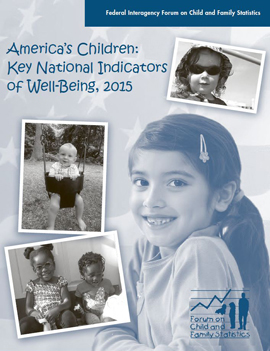Annual statistics compilation also shows increase in adolescent depression
Friday July 10, 2015
 The number of American infants born before the 37th week of pregnancy dropped slightly in 2013, as did the percentage of children with asthma under the age of 17. The percentage of teens who experienced a major depressive episode increased.
The number of American infants born before the 37th week of pregnancy dropped slightly in 2013, as did the percentage of children with asthma under the age of 17. The percentage of teens who experienced a major depressive episode increased.
These and other findings are described in America’s Children: Key National Indicators of Well-Being, 2015. The report was compiled by the Federal Interagency Forum on Child and Family Statistics, which includes participants from 23 federal agencies. The forum fosters coordination, collaboration, and integration of federal efforts to collect and report data on children and families.
According to the report, youth who have had a major depressive episode in the past year are at greater risk for suicide. They are more likely than other youth to initiate alcohol and other drug use, experience concurrent substance use disorders, and smoke daily. A major depressive episode is defined as a period of at least two weeks when a person experienced a depressed mood or loss of interest or pleasure in daily activities, plus four other symptoms of depression, such as problems with sleep, eating, energy, concentration, and feelings of self-worth. The report noted that the percentage of youth ages 12-17 who experienced a major depressive episode increased from 9 percent in 2004 to 11 percent in 2013. Those who received treatment for such an episode declined from 40 percent in 2004 to 38 percent in 2013.
Infants are considered preterm if born before 37 weeks of gestation. In 2012, 11.5 percent of babies were born preterm. That rate dropped to 11.4 percent in 2013. It is the seventh straight year that this percentage rate has declined.
The percentage of children younger than 17 with asthma also dropped to 8 percent in 2013 from 9 percent in 2012.
Poverty rates among children declined, according to the report. The percentage of children living in poverty dropped to 20 percent in 2013 from 22 percent in 2012. The percentage of children with at least one working parent increased during the same time period. Similarly, the percentage of children in households experiencing housing problems also has declined.
This year’s report is the 17th in an ongoing series and presents key indicators of children’s wellbeing in seven domains: family and social environment, economic circumstances, health care, physical environment and safety, behavior, education, and health.
Regarding behavioral indicators, 10th and 12th graders were less likely to smoke, and eighth and 12th graders were less likely to have reported binge drinking (five or more alcoholic drinks in a row) in the two weeks prior to the survey.
Within the overall population of children, the percentage of children declined to 23.1 percent in 2014, from 23.3 percent in 2013 Among the child population, the percentage of White, non-Hispanic children declined slightly, and there were slight increases in the percentage of children classified as Hispanic, Asian, non-Hispanic, and of two or more races, non-Hispanic.
The percentage of births to unmarried women continued to decline, from 41.0 percent in 2009 to 40.6 percent in 2013. In 2013, the teen birth rate was 12 per 1,000 adolescents ages 15–17, a record low.
Indoor air quality has shown long-term improvement, as the percentage of children ages 4–11 exposed to second hand smoke, measured by detectable blood cotinine levels, has declined from 85 percent in 1988–1994 to 40 percent in 2011–2012. Outdoor air quality also has shown improvement, with the percentage of children living in counties with a measured pollutant above the level of the federal air quality standards at least once declining from 68 percent in 2012 to 50 percent in 2013.
Among the education indicators, mathematics scores improved for fourth and eighth graders, and reading scores improved for eighth graders. For grades four and eight, the average mathematics score in 2013 was higher than in all previous years since 1990. Additionally, the high school completion rate has increased over time for young adults, and most notably for Hispanic young adults, from 57 percent in 1980 to 85 percent in 2013.
This year’s report also included a special feature, Health Care Quality, which noted these trends:
- Overall, the percentage of children ages 0–17 who had a well-child or adolescent visit in the previous 12 months increased from 73 percent in 1997 to 83 percent in 2013.
- The percentage of children ages 3–5 who had at least one vision screening increased from 54 percent in 2002 to 61 percent in 2012.
- The percentage of children ages 0–17 with asthma who had received an asthma management plan increased from 41 percent in 2002 to 51 percent in 2013.
- Among children ages 0–17, the percentage who were unable to receive or were delayed in receiving medical care, dental care, or prescription drugs declined from 6 percent in 2002 to 4 percent in 2012
Download a copy of the 2015 America’s Children report.
###
About the Eunice Kennedy Shriver National Institute of Child Health and Human Development (NICHD): The NICHD sponsors research on development, before and after birth; maternal, child, and family health; reproductive biology and population issues; and medical rehabilitation. For more information, visit the Institute’s website at http://www.nichd.nih.gov/.
About the National Institutes of Health (NIH): NIH, the nation's medical research agency, includes 27 Institutes and Centers and is a component of the U.S. Department of Health and Human Services. NIH is the primary federal agency conducting and supporting basic, clinical, and translational medical research, and is investigating the causes, treatments, and cures for both common and rare diseases. For more information about NIH and its programs, visit http://www.nih.gov.

 BACK TO TOP
BACK TO TOP